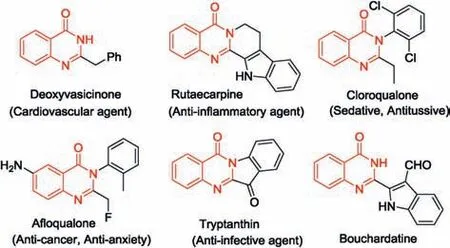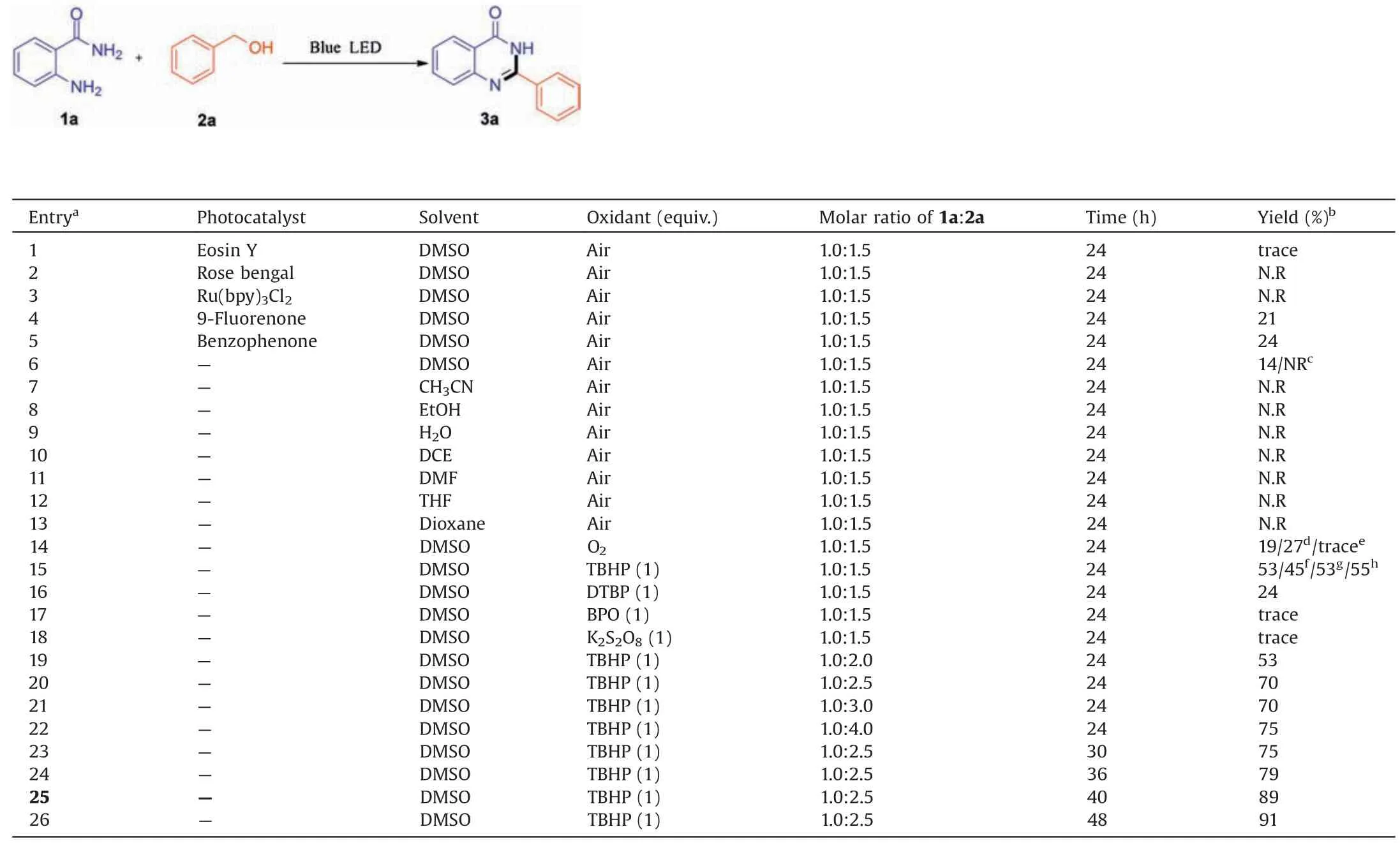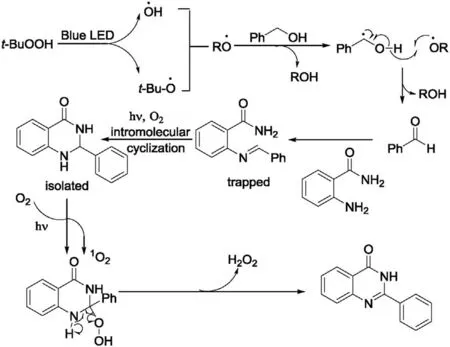Visible light induced tandem reactions:An efficient one pot strategy for constructing quinazolinones using in-situ formed aldehydes under photocatalyst-free and room-temperature conditions
2021-10-14ZongboXieJinLanHaiboZhuGaoyiLeiGuofangJiangZhanggaoLe
Zongbo Xie,Jin Lan,Haibo Zhu,Gaoyi Lei,Guofang Jiang*,Zhanggao Le*
Jiangxi Province Key Laboratory of Synthetic Chemistry, School of Chemistry, Biology and Material Science, East China University of Technology, Nanchang 330013, China
ABSTRACT A facile tandem route has been developed for constructing quinazolinones from various aminobenzamides and in-situ generated aldehydes.Visible light was found to play a dual role:first oxidizes the alcohol to the aldehyde and then facilitates its cyclization with o-substituted aniline.Furthermore,alcohols are perfect alternatives to aldehydes because they are greener,more available,more economical,more stable,and less toxic than aldehydes.The first reaction step continuously provides material for the second step,which effectively reduces loss through volatilization,oxidation,and polymerization of the aldehyde, while avoiding its toxicity.A variety of quinazolinones can be prepared in the presence of visible light without any additional photocatalyst.The developed synthesis protocol proceeds with the merits of mild conditions,broad substrate scope,operational simplicity,and high atom efficiency,with an eco-energy source under metal-free, photocatalyst-free, and ambient conditions.
Keywords:Visible light Photocatalyst-free In-situ formed acetaldehyde One pot tandem reaction Quinazolinones Room temperature
Quinazolinones and their scaffolds are widely used in many fields, especially organic, natural product, medicinal, and agricultural chemistry.For example, the quinazolinone motif and its derivatives are abundant in a number of synthetic compounds and natural alkaloids with diverse biological and pharmacological properties (Fig.1), including antimalarial [1],antimicrobial [2], anticancer [3], anti-inflammatory [4,5],anticonvulsant [6], antihypertensive [7], antitumor [8-10],anti-diabetic, dihydrofolate reductase-inhibitory, and kinaseinhibitory activities [11-15].The substituents at the 2 and 3 positions of the quinazolinone nucleus have been reported to markedly influence pharmacological activity [16].In view of their importance,several reports have appeared in the literature describing the synthesis of these heterocycles.Among these methods, reacting o-substituted anilines with an aldehyde appears to be the most-employed strategy, with various catalysts used to promote this reaction, including cellulose-SO3H [17],thiamine hydrochloride (VB1) [18], p-TSA [19], β-cyclodextrin-SO3H[20],2-morpholinoethanesulfonic acid[21], L-proline nitrate[22], SiO2-H3PW12O40[23], chiral phosphoric acids [24], ascorbic acid [25], ionic liquids [26,27], zirconium (IV) chloride [28],scandium triflate(III) [29] and metals [30,31] (Scheme 1A).As a class of compound, alcohols are known to be greener, more economical, more stable, more available, and less toxic than aldehydes.In recent years,the use of alcohols instead of aldehydes has also aroused interest,and various catalysts such as Ru [32],Ir[33,34],Pd[35],Pt[36-38],Zn[39],Cu[40,41],Fe[42-44],Ni[45],KOH[46]or high temperatures[47,48]have been used to prepare these compounds (Scheme 1B).Therefore, the development of more practical, green, and efficient approaches to quinazolinones remains an attractive task for organic chemists [49].

Fig.1.Selected examples of biologically active quinazolines.
Visible light is clean,easy to handle,and an eco-friendly energy source with excellent prospects for the development of sustainable and eco-friendly protocols.Owing to these advantages, visiblelight-promoted chemical reactions have received considerable attention and have emerged as a hot research topic in organic chemistry [50-68], water splitting [69], PCN materials [70],organic photocatalyst [71] or applications in medicine synthesis[72].As a continuation of our interest in visible-light photochemistry and inspired by the reported results [73],herein we report a novel,green,and mild protocol for the synthesis of quinazolinones by irradiating alcohols and o-substituted anilines with visible light under photocatalyst-free and room-temperature conditions(Scheme 1C).To the best of our knowledge, this is the first example of quinazolinone synthesis involving a tandem reaction promoted by visible light.

Scheme 1.Routes used to synthesize quinazolinones.
To optimize the reaction conditions, we initially chose 2-aminobenzamide (1a) to react with benzyl alcohol (2a) as a model system.To achieve a green reaction outcome,we examined photocatalysts such as eosin Y, rose bengal, Ru(bpy)3Cl2, 9-fluorenone, and benzophenone.The reaction was carried out in DMSO under light from an 18-W blue LED in air for 24 h when 9-fluorenone or benzophenone (5.0 mol%) was used as the photoredox catalyst; pleasingly the reaction proceeded to afford the desired product 3a in 21% or 24% yield, respectively (Table 1,entries 4 and 5).To our delight,3a was obtained in 14%yield when the model reaction was conducted in DMSO in the absence of a photocatalyst (entry 6).A further control experiment without the photocatalyst and without irradiation with LED light only recovered the two starting materials (entry 6).Subsequently, a number of solvents,oxidants,times,and molar ratios of substrates were examined with the aim of improving reaction efficiency.It is noteworthy that, among the solvents screened (entries 6-13),the target product was obtained only in DMSO as the solvent(entry 6).Furthermore, when various oxidants were screened (entries 14-18), a slightly improved yield of 3a was achieved when an oxygen balloon was used instead air (entry 14 vs.6).At the same time,with O2as the greenest oxidant,we attempted to increase the yield by extending the reaction time, but only obtained 3a in 27%yield (entry 14); however,3a was only obtained in trace amounts when the reaction was performed in a nitrogen atmosphere(entry 14).It should be noted that tert-butylhydroperoxide (TBHP) was the most effective oxidant for the reaction,affording product 3a in 53%yield(entry 15);therefore,TBHP was selected as the oxidant in subsequent experiments.The amount of oxidant was next investigated, which revealed that that the initial choice of TBHP(1 equiv.) was fortuitous.The 1a:2a ratio, as well as the reaction time were also optimized,the results of which are summarized in Table 1 (entries 15,19-26).

Table 1 Optimizing the reaction conditions for the synthesis of 3a.a
With the best reaction conditions in hand (entry 25), we explored the generality of this methodology using various substituted benzyl alcohols, the results of which are summarized in Scheme 2.The good news is that electron-rich benzyl alcohols,including sterically bulky ortho-substituted ones (3d) generally furnished good-to-high yields of products(3b-3e).To our delight,4-chlorobenzyl alcohol still afforded a satisfactory yield of the product (3f).The yield obtained using cinnamyl alcohol was also satisfactory (3 g), and the reaction of bulky naphthylmethanol successfully gave the desired product(3 h).Moreover, 3-pyridinemethanol and 2-thiophenemethanol were chosen to investigate the reaction scope of heterocyclic alcohols, both substrates produced the target products in high yields(3i,3 j).Subsequently,various primary alcohols all gave the corresponding products in satisfactory yields (3k-3n), however, the yield was observed to decrease with increasing alkyl chain length.Meanwhile, a cycloalkyl containing alcohol (cyclobutanemethanol) also successfully afforded the corresponding product (3o).It is worth mentioning that methanol and secondary alcohols, such as isopropanol can also react well(3p-3 r).Methanol is used to replace formaldehyde in one-step synthesis to make the reaction more operable because formaldehyde is a gas.The application of secondary alcohols has greatly expanded the scope of substrates.
To explore the generality of this protocol,we examined a variety of aminobenzamide derivatives.Halogenated aminobenzamides gave the corresponding quinazolinones in good yields (3 s, 3t),while an alkyl substituted 2-aminobenzamide was more sluggish and afforded the corresponding product in moderate yield at a prolonged reaction time (3 u).Finally, an N-substituted 2-aminobenzamide satisfactorily produced the desired product.The yields obtained for 3v and 3 w reveal a very obvious spatial effect.
Several control experiments were conducted with the aim of clarifying the reaction mechanism(Scheme 3).To understand the role of TBHP,we first reacted 1a with 2a in air,which provided 3a in 34% isolated yield, while nitrogen instead of TBHP provided 3a in very low yield(Scheme 3a).We then observed that benzyl alcohol can be converted into benzaldehyde under the standard conditions(Scheme 3b),and that replacing benzyl alcohol with benzaldehyde also led to the successful formation of 3a under the above conditions in a little less time.Moreover, we found that 2,2,6,6-tetramethylpiperidine-N-oxide(TEMPO),a commonly used radical scavenger, completely inhibited the model reaction under the standard conditions, indicating that the reaction may involve a radical pathway (Scheme 3d).Further, the expected intermediate could be successfully prepared from benzaldehyde and 2-aminobenzamide in the presence of visible light and O2(Scheme 3e);then intermediate could be transformed into product 3a in high yield under visible-light promoted aerobic oxidative conditions (Scheme 3f).

Scheme 2.Substrate scope of the visible light promoted aerobic oxidative annulation of secondary alcohols with various aminobenzamides.Reaction conditions: 1(0.20 mmol),(0.5 mmol),TBHP(1 equiv.),and DMSO(1.5 mL)irradiated with an 18 W Blue LED at room temperature.The syntheses of 3k-3v use 0.5 mL of the alcohol and 1 mL of DMSO as solvent for 40 h; 3 u (50 h).
To confirm whether or not the reaction involves a chain process,a “light on/off experiment” was performed.Fig.2 reveals the product was not generated during the dark period,confirming that light is required throughout the entire reaction period.

Fig.2.Alternating light on/off experiment with 1a and 2a.
Based on the above results, we propose a plausible reaction pathway (Scheme 4).Initially, photoirradiated TBHP produces hydroxyl radicals and tert-butoxyl radicals.Hydrogen atom transfer from benzyl alcohol to the tert-butoxyl radical or the hydroxyl radical gives the α-hydroxybenzyl radical; subsequent the radicals between hydroxyl radicals or tert-butoxy radicals and carbon atom groups undergo a classic alkoxy radical disproportionation reaction [74] driven by polar effects to generate benzaldehyde.Then, 2-aminobenzamide and benzaldehyde are dehydrated and condensed to form imine intermediate.Subsequent intramolecular cyclization gives another intermediate.Finally,visible light irradiation to produce singlet oxygen through energy transfer pathways, lead to the release of H2O2to form the target product [75].

Scheme 3.Control experiments.

Scheme 4.Plausible reaction mechanism.
We developed a novel, simple, efficient, and catalyst-free method for the construction of quinazolinones through the visiblelight-promoted in-situ generation of aldehydes from alcohols and subsequent reactions with various 2-aminobenzamides at room temperature.Visible light is necessary in both steps of the tandem reaction.This work solves some of the problems associated with the use of metals, bases, and high temperatures during the synthesis of quinazolinones, as well as avoiding the direct use of aldehydes.Meanwhile, this protocol features mild, tolerant, and operationally simple photocatalyst-free conditions that are easy to implement,and represents a significant green-chemistry enhancement over existing protocols.
Declaration of competing interest
The authors report no declarations of interest.
Acknowledgments
This project was supported by the National Natural Science Foundation of China(No.21462001)and a Science and Technology Project of Jiangxi Province (No.20192BBH80012).
Appendix A.Supplementary data
Supplementary material related to this article can be found, in the online version,at doi:https://doi.org/10.1016/j.cclet.2020.09.059.
杂志排行
Chinese Chemical Letters的其它文章
- D-A-D structured selenadiazolesbenzothiadiazole-based near-infrared dye for enhanced photoacoustic imaging and photothermal cancer therapy
- Synthesis and biological evaluation of a lipopeptide-based methamphetamine vaccine
- Nucleic acids induced peptide-based AIE nanoparticles for fast cell imaging
- Titanate nanofibers reduce Kruppel-like factor 2(KLF2)-eNOS pathway in endothelial monolayer: A transcriptomic study
- Drug-induced hierarchical self-assembly of poly(amino acid) for efficient intracellular drug delivery
- Co-delivery of anticancer drugs and cell penetrating peptides for improved cancer therapy
